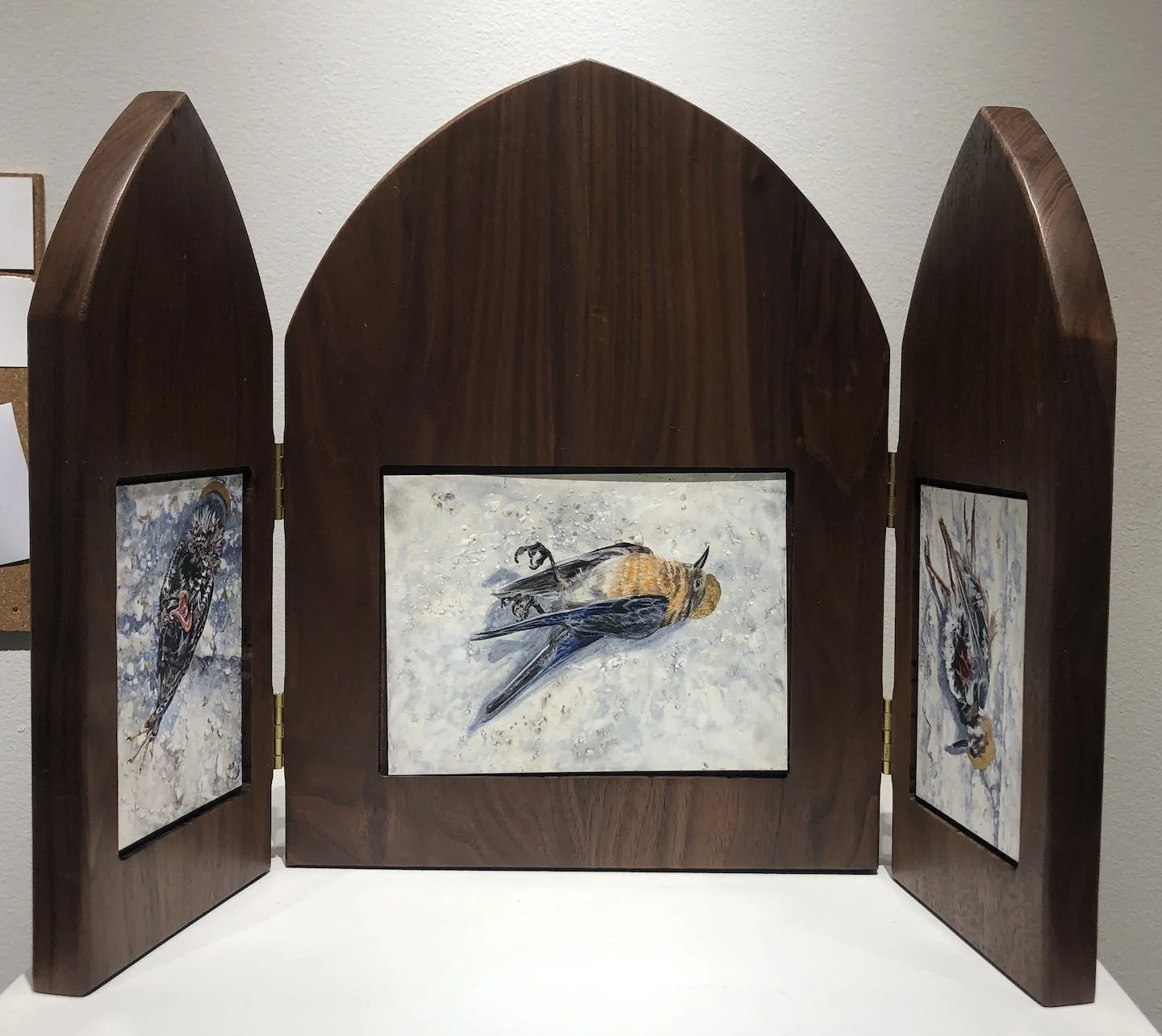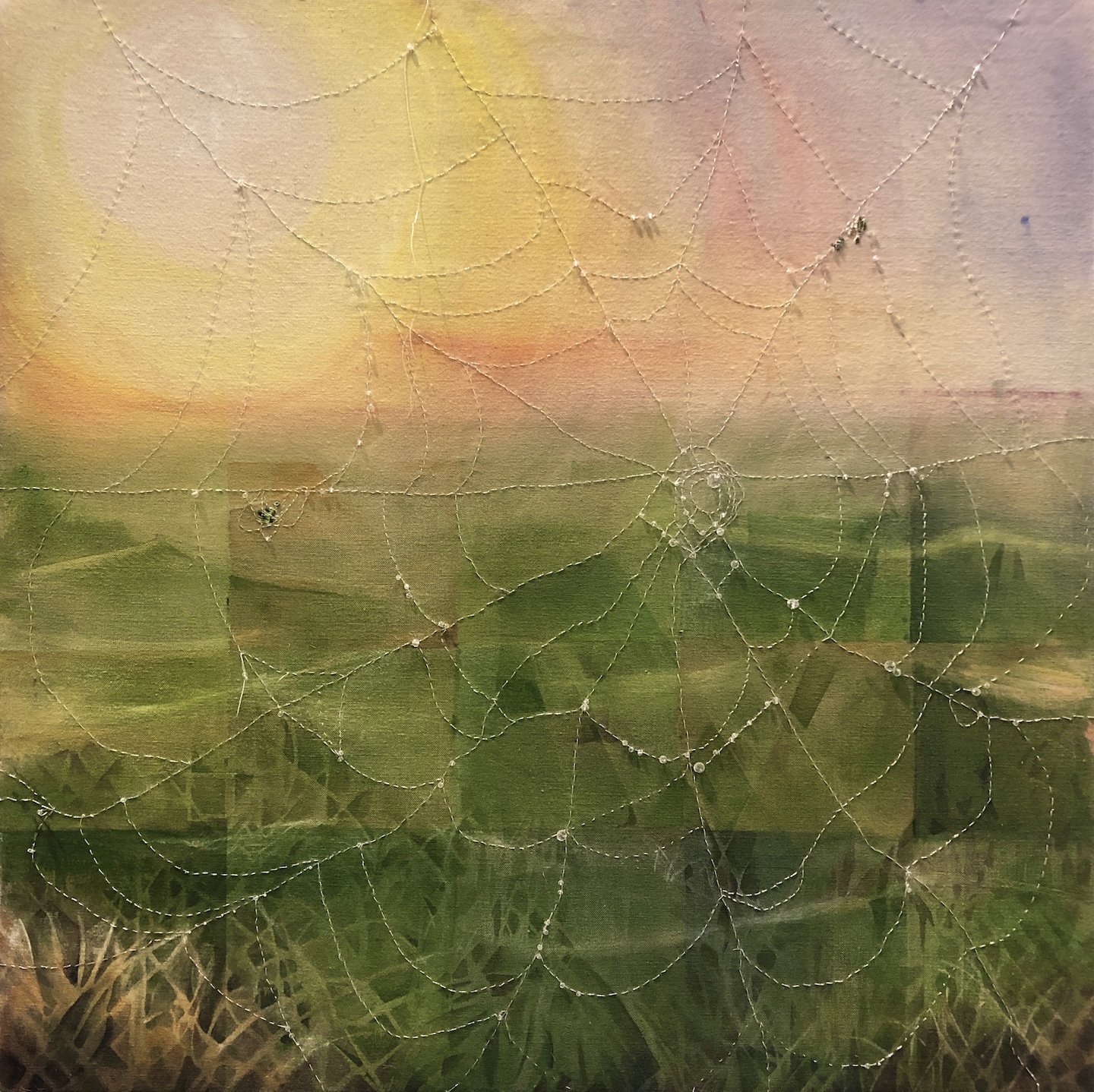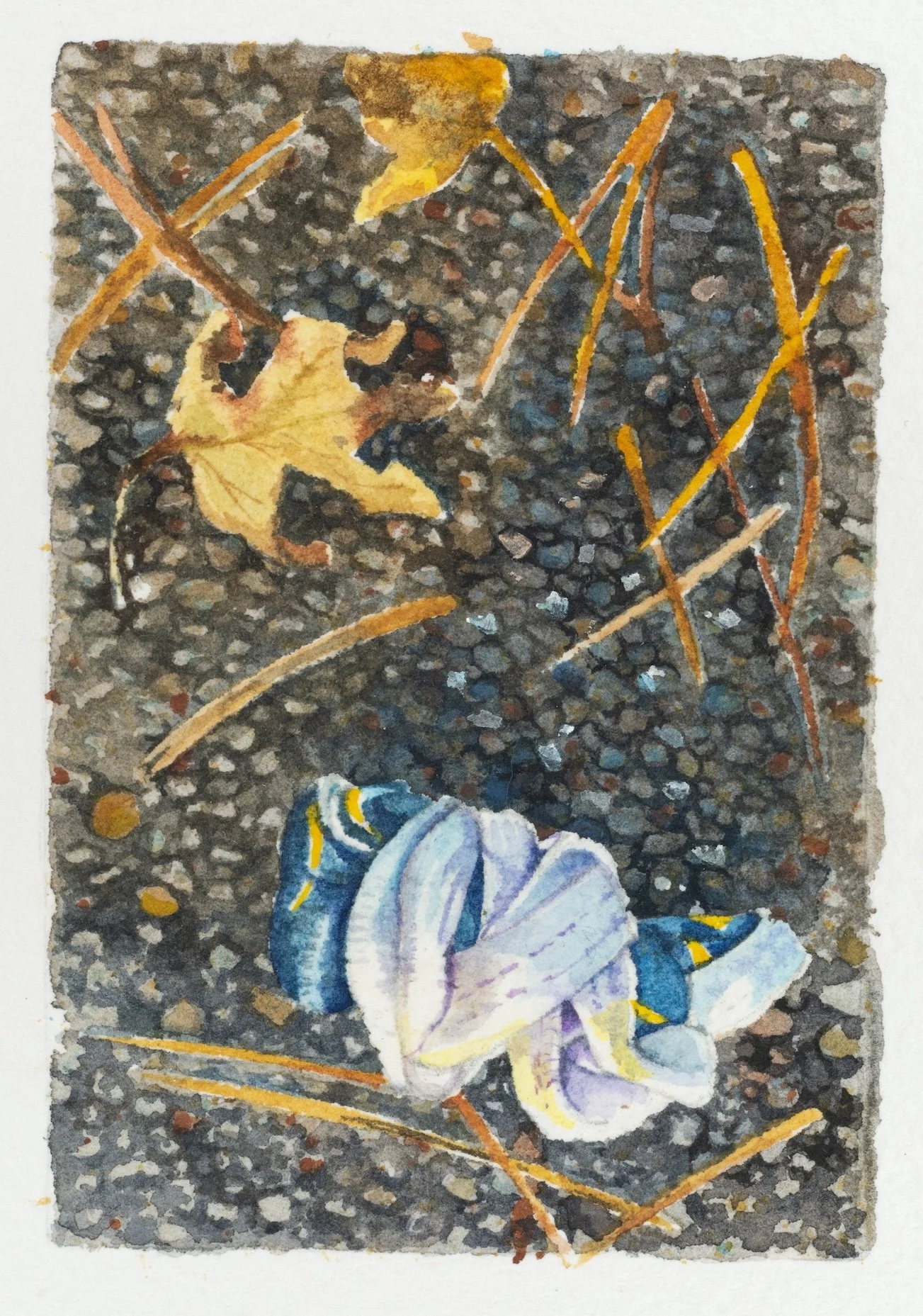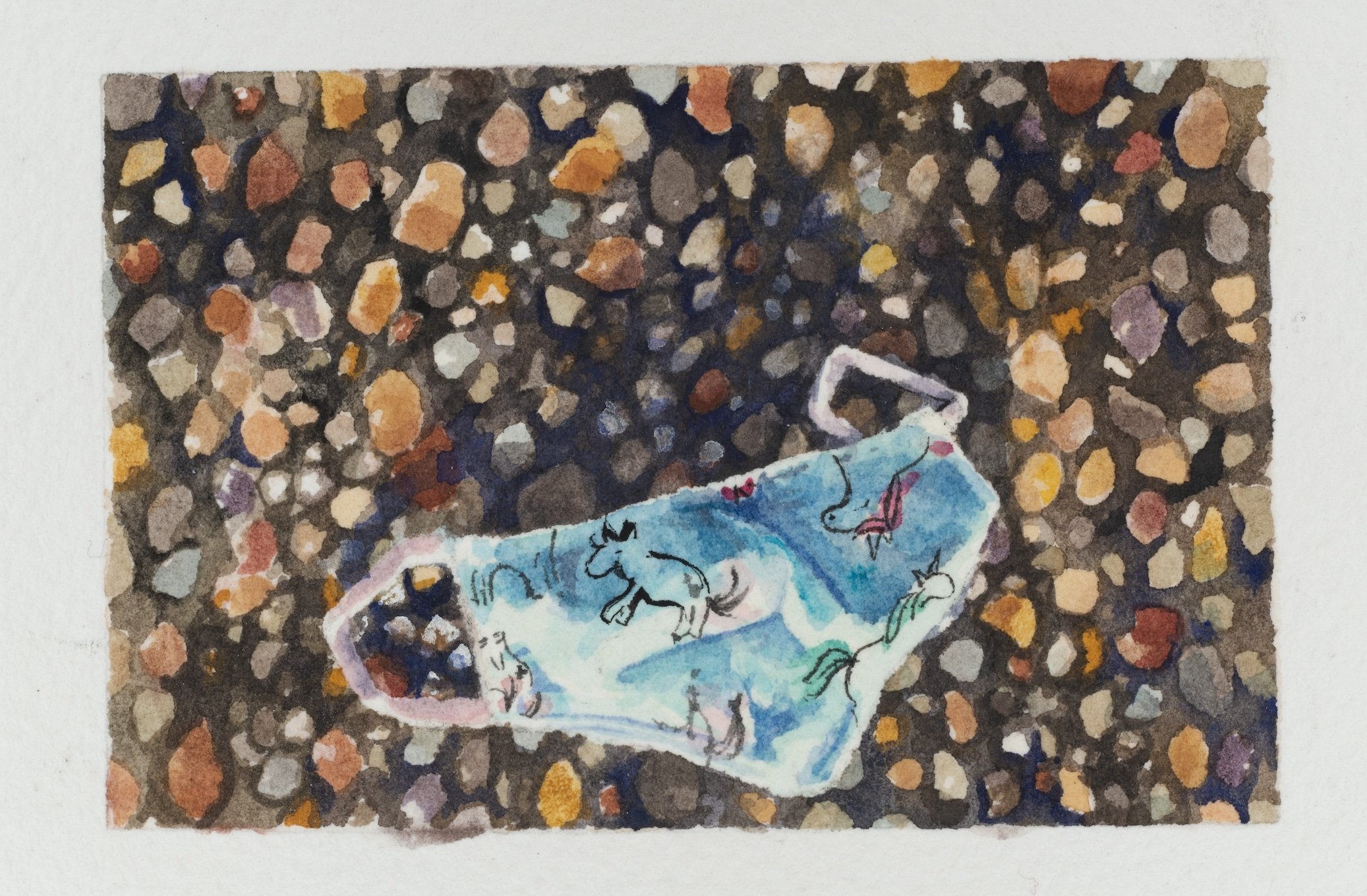Interview with artist Rhaelene Rollins Lowther
Rhaelene Rollins Lowther is a multimedia artist and art professor at Southern Arkansas University in Magnolia, Arkansas. She earned a BFA in painting from Brigham Young University and an MFA in Digital Media from Utah State University and worked in the video game industry for 10 years before beginning her career in education. More of Rhaelene’s work can be found at her website.




AAS: Rhaelene, where did you grow up?
RRL: I was born in Logan, Utah, but my family moved to California when I was five, so I grew up in Paso Robles, a small town in central California. I graduated high school in Minnesota though, since my parents moved there during my junior year of high school. I attended Brigham Young University in Provo for my undergraduate education. I married a couple years before graduating from BYU and had my first child before graduating. Our other two children were born while I worked in the video game industry.
When starting college, I thought I wanted to pursue art therapy, but once I started taking studio art classes, I focused on painting and actively pursued a BFA in painting. When I was nearing the end of my degree I added a minor in psychology, thinking I might still apply to graduate schools for art therapy but not entirely sure about that path. Because I didn’t feel confident in just pursuing studio art and not sure about art therapy, I added an extra year and a half to my undergraduate education and added a second bachelor’s degree in art education. I then worked in the video game industry for ten years.
AAS: What brought you to Arkansas?
RRL: When I was getting ready to graduate with my MFA from Utah State University, I applied to college teaching jobs related to my skill set, primarily those teaching digital art, since that was what I had done professionally for 10 years. I applied for and was offered a job at Southern Arkansas University. I accepted the job here because I liked the department, and I was excited to come in on the ground floor of a program. The Game Development program at SAU had just been approved by the Arkansas Department of Higher Education and I came in helping to create the program and really establish the program at both SAU and the region. We were the first game program in the state of Arkansas and thus were able to establish game development in the region. During my time here, I have grown the program, created a game development camp for teens, an Indie Game festival, and had the privilege to meet and work with people around the whole region.
AAS: I find it so interesting that you were in the gaming industry before becoming a college educator. How did you get into video game art?
RRL: Shortly after my undergraduate college graduation, a friend of mine from college worked as a programmer at a game company and let me know when they had artist positions open. Despite my lack of experience in digital art, I applied for a position at the company, Access Software in Salt Lake City, and got the job. Because this was in the 1990’s, there weren’t really college programs teaching game art and animation yet, so companies knew they would be doing on the job training and were looking for foundational art skills more than software skills for art. I really only planned on working at this job for a year or two while I continued to apply for high school art teaching jobs. However, Access software was acquired by Microsoft Game Studios and it was honestly too good of a job opportunity to pass up.
I worked for five years at Access Software/Microsoft Games as an environment artist, creating digital 3D art assets for the worlds in video games: things like trees, rocks, fences, buildings, etc. In late 2003, I was laid off along with 50% of the studio.
In 2004 I began working at another Salt Lake City game studio, Sensory Sweep Studios and worked there for about five years as well. During my time there I worked primarily on games for the Nintendo DS. After Sensory Sweep Studios shut down, I decided I did not want to work in games any longer and wanted to go back to teaching, but not at the high school level. I instead went to graduate school so that I could teach at the college level.
AAS: The first time I saw your work was in the Small Works on Paper 2023 travelling exhibition and I fell in love with Eyes Too Big for the Stomach. Tell me about the exhibition and that piece.
Eyes Too Big for the Stomach, watercolor and thread on paper, 7.5” x 5”
RRL: In 2019 I created a series, Daily Practice, painting small 2” x 2” paintings based on something I had seen that day, usually while walking my dog Fin. This influenced later work, like Eyes Too Big for the Stomach which is part of my series Allegories and Idioms. For these I would take photos for reference, and they became a kind of tableau that made me think of allegories and idioms we hear about but also see in our daily lives and in the lives of the bugs and plants and wildlife around us. I have loved mixed media and fabric arts in fine art for decades but hadn’t done much to explore it myself, barring a couple of exceptions in college and incorporating fabric arts connections in my MFA digital art project. I was drawn to the concept behind the small spider eating the large bug that is the primary subject matter of the painting, but I also like the ephemeral quality of the spider webs in which the large bug is caught, the thin silken strands that caught and hold the prey. So I decided to add clear thread sewn into the paper to give both more weight than paint would have, but less because it is thin and clear.
The Grasshopper and the Ants, watercolor on paper, 8” x 8”
I had submitted works to Small Works on Paper a couple of times before 2023 but hadn’t had any works accepted. I submitted two of my watercolors, Eyes Too Big for the Stomach and The Grasshopper and the Ants, from Allegories and Idioms to the 2023 SWOP and had both accepted. I was very excited to have my work shown around the state of Arkansas and to be shown with so many other artists whose work I have admired since moving here. I was totally blown away and honored by having my work selected to be on the marketing materials for 2023.
AAS: I want to ask you next about Left Behind. It is a large painting and part of a series you began during Covid. It is not just symbolic, it really tells – or now reminds – us of an important time. Tell me about it and what the response has been to that series.
Left Behind, acrylic on canvas, 44” x 36”
RRL: In 2020, I saw masks begin appearing on the ground almost daily on my walks. The first few times I took photos but hadn’t decided to make paintings of them. But then I decided I wanted to document this time and not only make paintings, but perhaps something more. Because of Fin I always had small bags with me to clean up after her, which made it easy to collect the masks I found. I wasn’t sure exactly what a show might look like, but I imagined a full show or installation of work surrounding the actual masks. After 57 of the small paintings, I was all of a sudden done. It was very abrupt, I was part of the way through painting #58 and I just didn’t want to finish it. I kept thinking I would take a break for a few days or weeks and go back to it but I didn’t. When I finally went back to it I no longer wanted to create the documentary type small paintings but rather more ambitious, larger paintings with more symbolism in them.
Left Behind is from what became the Lost and Discarded series. It is of a mask I found under a bush that actually sat in the same place for a couple months along with another piece of trash that slowly fell apart over that same time, while the mask stayed essentially the same. I also added a bleached out crawfish exoskeleton to the piece to go along with larger themes of transformation and chaos and order that had been a part of some of my artworks in the last few years. Left Behind also introduced more obvious structural lines and forms. I have always been interested in the formalism of dividing the canvas—in formal and informal ways we use for composition and what bigger meanings these structures might imply. Many of my artworks have been composed upon formalist structures like the golden rectangle or the rule of thirds, but I brought to the front some of this implied geometry, making it visible in Left Behind. The idea that we try to somehow impose order on chaos is part of the idea I was exploring with this piece.
I showed Lost or Discarded as a complete installation in the fall of 2022 in the Brinson Gallery at SAU. It was received positively, although it did make people uncomfortable as we all try to move on from our experiences in lock down and the pandemic but also still live with the aftereffects. Whether alone or shown all together, the mask paintings pull us all back to a time of global fear that also was so universal an experience that it is also a source of connection and shared experience.
AAS: Your artworks are very tied to the natural world. Were you always outside and exploring as a kid?
RRL: As a child I explored a lot outdoors, but I also read a lot. Both types of exploration have impacted the way I experience the natural world. I am honestly not nearly as outdoorsy as many people I know—I don’t go hunting or fishing and I used to hike when I lived out west but haven’t actually hiked much in Arkansas. I think as much as the time spent outdoors in childhood and young adulthood impacted me, the exploring I did through books may have been as impactful. A book that I think really changed the way I see the world is Annie Dillard’s Pilgrim at Tinker Creek. I read this book in my 20’s and have been thinking of the imagery and the connections she makes between prosaic moments and the divine ever since. I discovered Mary Oliver’s poetry about three or four years ago and it had a similar impact on me that Annie Dillard’s prose had. Both make taking the time to see, experience and think about the nature in which we live seem akin to meditation and a way for us to connect to the divine, both the idea of God and the divine within each of us. I have now started reading other poets and my current favorite is Ada Limon. I love how all these authors describe nature but eventually bring a universality to the specific and I would like to be able to do the same with my visual art.
“One thing that I explore in most of my paintings is the interplay between background and foreground, subject matter, and negative space, and mixing the two.”
AAS: Tell me about your amazing watercolor, Dead Crawfish. Growing up in south Louisiana there were many crawfish mounds in our yard!
Dead Crawfish, watercolor on aquaboard, 5” x 7”
RRL: In 2020 I started walking with Anna Zusman, a fellow art professor at SAU. We found when walking together that we often found the same things interesting but approached the idea of them becoming art in different ways. We also found that we often talked about artists, ideas for artworks and teaching, etc. and these conversations influenced our work. We decided to create a series of works, Quotidian Moments Through Different Lenses, which would be based on the same inspirations from our walks, knowing that we would approach them in very different ways. We intended this to be a fairly straightforward series-- 12 artworks each in the course of a semester, so roughly one artwork a week. After the first week we both realized we wanted to spend more time and be more experimental, especially since we were talking about the work on our walks, which sparked further ideas.
Neither of us are from the south and so while we recognize crawfish when we saw them on the paths we walk, especially along Lake Columbia near Magnolia, neither of us recognized the skeleton as a dead crawfish. It seemed so exotic, so foreign to anything we normally saw. The painting I created was a fairly faithful rendering of what we saw, with a focus on texture, both in the exoskeleton and the ground on which it sat. One thing that I explore in most of my paintings is the interplay between background and foreground, subject matter and negative space, and mixing the two. As I mentioned, transformation and the life and death cycle so evident in nature are fascinating to me and are evident in many of my artworks.
Dead Crawfish was one of the artworks that was a way for me to begin challenging myself to try new things. I had been painting with primarily watercolor for several years, and this is also watercolor, but I tried a new surface on which to work called aquaboard. It is a specialized ground that works beautifully with water media and allows me to pull up more of the paint than I can usually do with paper, so I am able to have more flexibility with the watercolors.
AAS: Another from that series is South Carolina Furrowed Fields with Queen Ann’s Lace. This one is more of a construction piece. Why did you choose that format to tell its story?
South Carolina Furrowed Fields with Queens Ann’s Lace, denim dyed and pieced and acrylic paint, 21” x 14.5”
RRL: Furrowed Fields with Queen Ann’s Lace is one of the recent pieces for Quotidian Moments Through Different Lenses. While the bulk of that collaboration with Anna was done in 2021, it is an ongoing series and I have continued to make a few pieces to add to the show. We had a mini artist residency at Southern Disclosure in South Carolina last summer and we were looking for images or moments that we both saw potential as reference for our collaboration. While on a walk in the countryside we saw these large furrowed fields shortly after a rainstorm with puddles in the fields and weeds, some of which were lovely Queen Ann’s lace. I was very drawn to the lines of field, the symmetry of it, broken up by the puddles and especially with the grass and flowers in the foreground.
Two projects I worked on as an undergraduate influenced this piece. First, I created a series of still life paintings of a quilt one of my grandmothers made and a crocheted blanket my other grandmother made, both of whom had died when I was a child. I loved the formal qualities of painting draped fabric and the color, line and form created as well as the connection with my past and the craftwork of my ancestors. I was also fascinated by the works of Helen Frankenthaler and Faith Ringgold and I moved from painting those still lifes in oil on panels to working with acrylic paint on unprimed canvas. I loved the staining of the fabric, the unpredictability of the materials together. The fascination with fabric art, quilt construction, embroidery, etc. as medium for art, has continued to fascinate me.
As I was composing this piece, compositing the grasses and flowers in front of the straight-lined fields, I was reminded of the lines of pieced quilts with applique on them. Quilts have a quality of reducing what we see into patterns. I both appreciate that quality of pattern but also fight against it to a certain extent. In Furrowed Fields I constructed the ground canvas with denim –because the color of the clouds and the water in the puddles looked like the color of worn denim– that I cut into strips, bleached and dyed half of them to be the brown of the dirt and left half blue denim that I then sewed together. Originally I had this stretched over stretcher bars, but in the end I chose to take the whole thing off the stretcher bars, sew the edges and hang it more like a fabric wall hanging.
AAS: Reverie is another lovely painting. Tell me about the layered effect you achieved only using color value.
Reverie, 2023, Acrylic on unprimed canvas, 24” x 24”
RRL: I mentioned that I’ve been thinking a lot about fabric art integrated in with traditional fine art materials and fine art aesthetic and of Helen Frankenthaler’s work as well as my earlier attempts to work with acrylic staining on canvas. I was also thinking of compositional construction lines and forms in a similar way to Left Behind, where we start to see the construction in the work itself and get a sense of our attempt as artists to visually organize what we see. With Reverie, I laid out a quilt like pattern on unprimed canvas and painted the geometric pattern with thinned glazes of acrylic so that the paint permeates the fabric and becomes as much a dye as paint. On top of this base layer, I painted the organic mix of grasses and wildflowers in a way more like watercolors on paper than traditional acrylic on canvas—utilizing thin washes and building from lights to darks in shapes of color and value to create the final image.
AAS: How do you think your experience in animation and 3D rendering affects the way you approach your painting?
RRL: When working in games, I was working with environments and not characters so I had to think about how pieces fit together for a given space, which definitely made me think more about composition. One of the parts of 3D modeling that I have always liked was creating the textures that are on the objects. They bring the object to life and they always felt very much akin to painting. I find that my paintings now, as opposed to those I created in my 20’s, have a greater focus on creating the illusion of texture and I fill up the space around the primary subject in a way I did not before working with 3D modeling and texturing.
I also think teaching animation and 3D modeling and rendering has impacted my work. I am always having to be very conscious to teach good practices in composition, lighting and form. These lessons are then more strongly in my thoughts as I approach my personal work.
Another thing that I bring to my classes, and my personal work is an emphasis on collaboration. The game industry and animation industry are highly collaborative, so that the end product was greater than the sum of its parts. I have found that while fine art is not always collaborative in the same way and doesn’t necessarily affect individual artworks, I do love finding ways to work with other artists.
AAS: Tell me about your classes in game design and game animation. What are students in the College of Liberal and Preforming Arts at Southern Arkansas University looking for?
RRL: At Southern Arkansas University we offer a Bachelor of Science degree in Computer Science with an emphasis in game development and a Bachelor of Fine Arts in Game Art, Animation and Simulation Design. I oversee the game art side of the program. As an undergraduate program, our game art degree is designed to introduce students to a range of disciplines within the game and animation industries. I teach classes that include 2D and 3D animation, 3D modeling, texture creation and character design. We introduce students to a variety of different professional areas – concept art, 2D animation, 3D animation, character modeling and digital sculpture, object modeling and texturing – as well as a range of types of professions that utilize these skills. We encourage them in their last year to focus more on one of the discipline areas. We also have classes that both art and programming students take together, primarily working on game projects as a team. We have the collaborative classes set up to reflect a studio type setting, including different team roles and project management expectations. Our students receive unique training, and I am proud to be a part of that.







